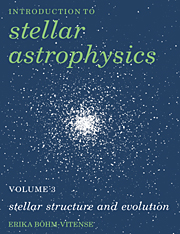Book contents
- Frontmatter
- Contents
- Preface
- 1 Introduction
- 2 Hydrostatic equilibrium
- 3 Thermal equilibrium
- 4 The opacities
- 5 Convective instability
- 6 Theory of convective energy transport
- 7 Depths of the outer convection zones
- 8 Energy generation in stars
- 9 Basic stellar structure equations
- 10 Homologous stars in radiative equilibrium
- 11 Influence of convection zones on stellar structure
- 12 Calculation of stellar models
- 13 Models for main sequence stars
- 14 Evolution of low mass stars
- 15 Evolution of massive stars
- 16 Late stages of stellar evolution
- 17 Observational tests of stellar evolution theory
- 18 Pulsating stars
- 19 The Cepheid mass problem
- 20 Star formation
- Appendix Radiative energy transport in stars
- Problems
- References
- Index
11 - Influence of convection zones on stellar structure
Published online by Cambridge University Press: 08 January 2010
- Frontmatter
- Contents
- Preface
- 1 Introduction
- 2 Hydrostatic equilibrium
- 3 Thermal equilibrium
- 4 The opacities
- 5 Convective instability
- 6 Theory of convective energy transport
- 7 Depths of the outer convection zones
- 8 Energy generation in stars
- 9 Basic stellar structure equations
- 10 Homologous stars in radiative equilibrium
- 11 Influence of convection zones on stellar structure
- 12 Calculation of stellar models
- 13 Models for main sequence stars
- 14 Evolution of low mass stars
- 15 Evolution of massive stars
- 16 Late stages of stellar evolution
- 17 Observational tests of stellar evolution theory
- 18 Pulsating stars
- 19 The Cepheid mass problem
- 20 Star formation
- Appendix Radiative energy transport in stars
- Problems
- References
- Index
Summary
Changes in radius, luminosity and effective temperature
In the previous chapter we considered only model stars in radiative equilibrium. We pointed out several mismatches between these models with real stars and attributed them in part to the influence of convection zones. Convection zones change stellar structure in two main ways:
(a) The radius of the star becomes smaller.
(b) The energy transport through the outer convection zones with the large absorption coefficients becomes easier due to the additional convective energy transport, so that the temperature gradient becomes smaller in comparison with radiative equilibrium. This may lead to an increased luminosity and Teff as well as energy generation.
If energy transport outwards due to convection is increased the star would tend to lose more energy than is generated, and so would tend to cool off. However, this does not actually happen, because it would reduce the internal gas pressure and the gravitational pull would then exceed the pressure force. The star actually contracts, the stellar interior temperature increases, thereby increasing the energy generation ∍ ∞ Tυ. With the larger energy generation the star is then able to balance the larger energy loss. The star is again in thermal equilibrium but with a smaller radius and a larger luminosity, which means with a larger effective temperature. As compared to radiative equilibrium the star moves to the left and up in the HR diagram (see Fig. 11.1). Convection decreases the equilibrium value for the radius.
- Type
- Chapter
- Information
- Introduction to Stellar Astrophysics , pp. 130 - 140Publisher: Cambridge University PressPrint publication year: 1992

